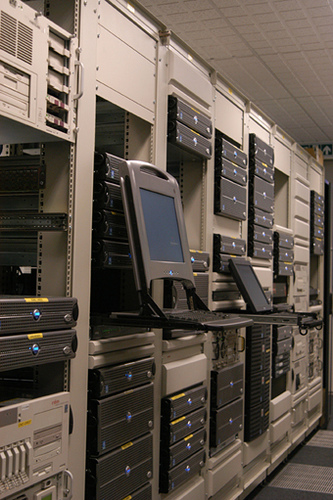Server Monitoring Options for the Remote Office

Server monitoring is an essential part of any remote office system. Problems with the server can stop work immediately and reduce revenue for days. Monitoring also helps businesses to tailor a particular server to the exact needs of employees and vendors. Server monitoring software comes in a variety of different forms. Most companies will use entire suites or multiple monitoring solutions in order to gather all of the data necessary. There are several different server monitoring options for a remote office.
Infrastructure
Infrastructure monitoring provides detailed metrics about the various hardware components the server is using. This includes the current central processing unit (CPU) load, memory usage and the input-output activity of a drive or storage array. This type of monitoring is valuable because it can detect hardware problems that might cause anomalous results when monitoring other software and network functions.
Network
Network server monitoring can be done through software but frequently involves a piece of hardware attached to the remote system. Network monitoring measures the current state of the server, the network and all active traffic. It will show mapping, packet routing as well as access requests. Network monitoring is used to help balance loads and maintain optimal performance. It is also an important tool when protecting a system from external attacks. This type of monitoring is essential for remote offices especially when the server is delivering cloud-based services to employees.
Application
Application monitoring involves using server monitoring software that sits inside of the application layer of a remote framework. This allows an administrator to see the vital statistics dealing with application execution. These statistics include running processes, stack and heap usage as well as application functions such as garbage collection. This provides an accurate picture of how the system is functioning from an end-user perspective. It will also show malfunctioning applications that could be reducing performance. Application monitoring provides a certain level of security against malicious programs that could otherwise run undetected on a remote office server.
Physical
Physical monitoring is different from most other options available. It is only useful in situations where the business owns the remote server and is privately leasing the space where the system is located. Physical monitoring uses a variety of hardware sensors in order to relay information about the state of the system and the surrounding environment. This includes ambient room temperatures, server temperatures and humidity levels. It can also be used to detect motion or sounds that indicate someone has entered the server room. Physical monitoring shows administrators external issues that could be causing problems with the hardware.
User
User monitoring can be done with various degrees of granularity depending on the system and the administrator. All administrators have some user tracking ability. Monitoring software expands this basic capability and can even provide real-time alerts and information. User monitoring targets the individual actions of each employee connected to the network. This can show individual usage, file system access and even peripheral device usage. This makes it easy to determine what systems need to be upgraded. It can also be used to determine if the actions of one or more employees is dramatically affecting system performance or violating basic office policies.


 Rachel
Rachel






